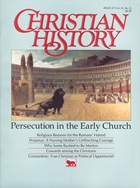Constantine has earned a place in history for many reasons—not least because he brought to an end the persecutions of Christians by the pagan Roman Empire. A concordat agreed to with his fellow emperor, Licinius, at Milan in 313 granted “both to Christians and to all others full authority to follow whatever worship each person has desired.… Every one of those who have a common wish to follow the religion of the Christians may from this moment freely and unconditionally proceed to observe the same without any annoyance or disquiet.” In retrospect, the agreement forms one of the major watersheds in the history of Christianity, bidding farewell to the age of the martyrs and presaging the era of the Christian Empire.
What sort of man was he, this Constantine “the Great,” the first emperor of Rome to come out unambiguously on the side of the Christian church? How significant were the so-called Edict of Milan and the other actions he took as patron of the church? How truly Christian was he himself?
Early Days
Constantine was born on February 27, probably in 272, in the military town of Naissus—modern Nis in eastern Yugoslavia. His father, Constantius, was an army officer; his mother, Helena, was a woman of lowly origins whom Constantius later (probably by 290) found it prudent to divorce as his political aspirations took shape. Not much is known for certain about their religious attitudes. Helena became a Christian—and one of outstanding piety only after her famous son’s conversion. Constantius enforced without enthusiasm only the first of the anti-Christian measures of the Great Persecution in Britain and Gaul (France)—the sector of the Empire he took charge of in 293 as a junior emperor (Caesar). One of his children by his second wife was named Anastasia, from the Greek word for “resurrection,” which implies pro-Christian sympathies going beyond mere tolerance. Eusebius later portrayed him as a worshiper of the one true God, but not in unmistakably Christian terms. The evidence suggests that Constantine could have acquired from his father a predisposition to take a serious look at Christianity when the opportunity offered.
As the son of a Caesar and hence potentially an emperor himself, Constantine spent a dozen years (from about 293 to 305) in the East in the court of Diocletian, the senior emperor (Augustus), and Galerius, his deputy (Caesar). Constantine could be regarded both as an imperial apprentice and as a hostage (ensuring the good conduct of his father). He passed the time partly in Diocletian’s palace at Nicomedia (modern Izmit, Turkey, not far from the eastern shore of the Bosporus) and partly in the field on military campaigns. Constantine’s religious development in these formative years is largely hidden from us, but he could hardly have been unaware of the Christians in an area of the Empire where they were thickest. The ranks of Diocletian’s officials and perhaps even his close family included some Christians, and the church building in Nicomedia was easily visible from the palace windows.
Taking over
The Great Persecution initiated from Nicomedia in 303 304 must have been highly distasteful to Constantine. In circumstances that scholars debate (did he flee at the first opportunity and take steps to prevent pursuit?), Constantine left Nicomedia soon after Galerius succeeded Diocletian (as Augustus) on May 1, 305, and made his way to Britain to his father—now also a senior emperor (Augustus). On Constantine’s father’s death at York on July 25, 306, his troops saluted Constantine as Augustus in his place. This was scarcely a regular (though not uncommon) route to the imperial throne, and Constantine would have to vindicate his right to rule on the battlefield.
To cut a tangled story short, on October 28, 312, he defeated Maxentius at the Milvian Bridge, a dozen miles up the Tiber from Rome, and thereby became sole master of the Western Empire. Twelve years later, he finally routed the forces of Licinius and became “Ruler of the Entire Globe”—or at least of the whole Empire.
Favoring the Christians
From the winter of 312–313 onward—that is, from soon after his triumphant entry into Rome as controller of the West—Constantine’s actions reveal increasing favor toward the Christian church. During those months he sent three letters to Carthage (near modern Tunis), the capital of Roman North Africa. The first ordered the Roman governor to restore to “the catholic church of the Christians in any city” all the property it had formerly owned, irrespective of its present owner. The second letter informed the bishop of Carthage that funds would soon reach him for distribution to “certain specific ministers of the lawful and most holy catholic religion,” and also assured him of protection against elements disruptive to the catholic church. The third letter, again to the governor, exempted clergy from the burdens of inherited responsibilities as local councillors. The reason given is highly significant: “The setting at nought of divine worship … has brought great dangers upon public affairs, and its lawful restoration and preservation have bestowed the greatest good fortune on the Roman name and singular prosperity on all the affairs of mankind (for it is the divine providence which bestows these blessings).” The clergy, “when they render supreme service to the Deity, … confer incalculable benefit on the affairs of the state.”
Religious Convictions
Sentiments like these resonate throughout Constantine’s letters and edicts. They reveal a deeply religious man who believed that the well-being of the Empire was dependent on God, and that God would prosper the fortunes of the Empire so long as he was truly worshiped by its inhabitants. This true worship (so Constantine held, with ever-sharpening clarity) was the worship offered by the Christian church, and the true God was the God of the Christians.
How Constantine came by these controlling religious convictions has long been disputed. Two Christian writers, Lactantius and Eusebius, had direct contact with Constantine in later years. They write that on the eve of the Battle of the Milvian Bridge, Constantine had a dream (Lactantius) or a vision (Eusebius) that convinced him to enter the fray, trusting in the Christians’ God, and to display a distinctively Christian emblem. The veracity of these accounts is, in the last resort, beyond corroboration. Nevertheless, they speak, in however embellished a form, of a decisive shift in religious allegiance—a conversion—and this is acknowledged today by eminent Roman historians, like Ramsay MacMullen and Timothy Barnes, who have no ecclesiastical axe to grind. As Norman H. Bayne wrote, Constantine’s action in confronting Maxentius “is more explicable if Constantine was convinced that the Christian God had assured him victory.”
It must be stressed, though, that the genuineness of Constantine’s pro-Christian stance does not depend on the historicity of the dream and the vision. It is writ unmistakably large in his words and deeds from shortly after the decisive victory. This consideration, for those who carry no prejudice against divine communications through dreams and visions, may properly count in favor of their authenticity in Constantine’s case.
Superficial Faith?
Constantine probably never gained a good grounding in Christian doctrine, however. As late as 324 he could regard the momentous divide opening up between the heretic Arius and his opponents as “a small and very insignificant question.” Only gradually and never frequently does he speak of “Christ” and “our Savior” rather than simply of “God” or, in more impersonal terms, “the divine power,” “providence,” “the supreme Deity,” etc.
Constantine was baptized only after the onset of his final illness, not many days before his death on Pentecost, May 22, 337. But if only then do we see him as a penitent (and delayed baptism was the norm at the time), the explanation lies largely in a circumstance too often forgotten or minimized by critics who depict him as a hypocrite, an impostor, or even a monster. It is simply this: Constantine was the emperor of Rome, the civil and military (and religious) head of the Empire. Our sources give us little access to the private Constantine. His letters and edicts are all official utterances. It is perhaps more remarkable that they make his religious convictions so clear than that they speak so little of Jesus Christ in terms of personal devotion.
Intermingled Paganism
Constantine’s religion is from first to last that of an autocratic ruler of an empire secured by military might—and still overwhelmingly pagan. If pagan elements did not disappear from his coinage immediately after his conversion, that should scarcely surprise us. Constantine’s legislative and executive actions can be fairly understood only when judged not anachronistically, against some ideal portrait of the Christian monarch (there were, after all, no precedents, no available role models, to guide a Roman emperor who was also a Christian), but historically, in a brutal age that took harsh retributive punishments for granted. And so his wife and eldest son had to die for offenses of treason. Not in vain did this Constantine bear the sword.
Yet in many details a Christian inspiration can be glimpsed in his legal enactments—for example, on the treatment of prisoners and slaves, on the status-less underclass of Roman society, on the exposure of surplus children, on celibacy and marriage and extra-marital infidelity.
But it is important not to make Constantine out to be more consistently Christian than he was. His conversion was not accompanied by a sharp break with his former paganism. Rather, a transition is discernible from the worship of the divine Sun to the service of the one true Christian God. When, in 321, he made the first day of the week a holiday, he described it as the day of the sun (but so do Christians today!). Christian regard for the Lord’s Day, however, alone motivated this ruling.
Consequences
Few individuals have set as many precedents as Constantine. He launched the church on its way to becoming the official, established religion of the Roman Empire—a journey it completed half a century later under Theodosius the Great. And by founding Constantinople as a “New Rome,” a Christian Rome, he laid the foundations for the noble Christian civilization of the Byzantine or East Roman Empire that would survive for a millennium after the Empire in the West had disintegrated. By his patronage Constantine aligned the former church of the martyrs—persecuted, powerless, and pacifist—with the military might and earthly glory of the state. Christianity would never be the same again.
Soon the wars of the Empire became holy wars; church leaders looked for civil sanctions to back up their ecclesiastical judgments (the Council of Nicaea deposed Arius; Constantine exiled him); rulers began to convene synods of church leaders and to influence or intimidate their proceedings; the church hierarchies learned how to invoke state coercion against heretics and schismatics, and they came to control increasing property and wealth. Persecution soon resumed of Christians by Christians, of pagans by Christians, of Jews and Moslems by Christians.
Yet if blame must be apportioned, much belongs not to Constantine but to those church leaders who not only, it seems, failed to teach him any better, but even, like Eusebius above all, constructed an extravagant theology of the Christian emperor that made him almost the earthly embodiment of divine power.
David F. Wright is dean of the Faculty of Divinity at the University of Edinburgh.
Copyright © 1990 by the author or Christianity Today/Christian History magazine.
Click here for reprint information on Christian History.

Support Our Work
Subscribe to CT for less than $4.25/month






























